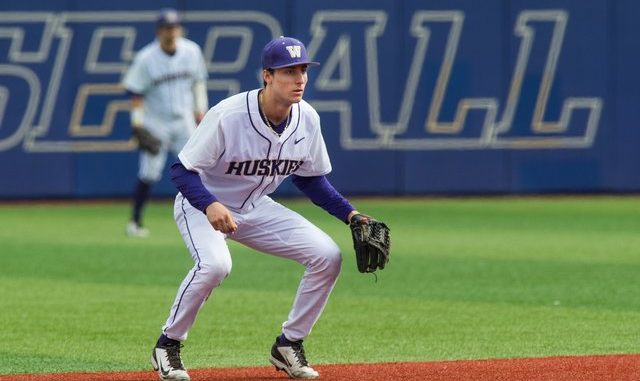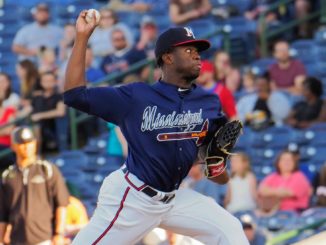
With the Braves without a third round pick due to MLB sanctions, the Braves moved to make the most of the 4th-round pick and got a player that many thought was a first-round talent. Most of the rest of the Day Two picks emphasized tools and signability.
Day One (Rounds 1-2)
Day Three (Rounds 11-40)
Fourth Round
Tristan Beck, RHP
Age: 21
6′-4″, 190 lbs
Stanford University
Beck has been on pro radar since his high school sophomore year, but he kept a strong commitment to Stanford despite being projected as a first round selection. He suffered a stress fracture in his back (the same injury that Braves first-rounder Kolby Allard had that caused him to drop to the Braves in 2015) before the 2017 season and had to have surgery, which likely cost him another shot at a first round selection. Instead, Beck didn’t care for the offers he was getting during the 2017 draft and elected to go back to school as a 4th-year junior.
Beck has a four-pitch repertoire (fastball, curveball, slider, change-up) that all rate at least average and he overwhelmed high school and college hitters earlier in his career. After his surgery, he didn’t show quite the same command as before, and his fastball velocity remains stubbornly in the 90-93 mph range. Beck’s delivery is somewhat unique, but he repeats it well. Beck is athletic and most importantly proved himself healthy over the course of the 2018 collegiate season.
Andy’s Thoughts: The Braves had been linked in reports to Beck for over a year, and getting a player expected to come off the board on Day One in the fourth round is somewhat of a coup. Beck was listed at 31 on Baseball America’s Top 500 draft-eligible players, so to have him drop 81 picks to the Braves indicate a strong mutual interest. It will be interesting to see Beck working with Braves instructors, who have a good track record of bringing out higher velocities from prospects in their early 20s, starting with former Vanderbilt pitcher Mike Minor.
Fifth Round
Trey Riley, RHP
Age: 20
6′-2″, 200 pounds
John A. Logan Community College (IL)
Riley started to get attention as a junior at Edwardsville High School (Illinois), but suffered knee and hamstring problems in his senior season that sapped his draft buzz. Riley went to Oklahoma State where he only got one appearance before transferring to Logan in order to get more innings.
At Logan in 2018, Riley showcased a potent two-pitch mix, with a fastball that sits in the 93-95 mph range and a potentially elite slider. Riley has shown a curveball and a change-up on occasion, but infrequently. Riley suffered from control issues early in the year, perhaps from pitching so little the previous two seasons, but improved in this area through the year. Riley pitched to a 1.85 ERA and struck out 117 batters in 77.2 innings pitched.
Andy’s Thoughts: Riley is a classic Braves upside pick with a slider that grades out highly. Riley could develop as a starter if he can continue improving control and a third pitch, but his repertoire would also seem to potentially play well out of the bullpen.
Sixth Round
Andrew Moritz, CF
Age: 21
Bats: L
University of North Carolina – Greensboro
Moritz is a junior who has won his collegiate conference batting title twice and is on his way to winning it again his junior year. Moritz has one of the better hit tools among college hitters with a college career batting slash line of .406/.466/.571 as of this writing, and he walks and strikes out at exactly the same rate. Contact is Moritz’s game, and he wants to split gaps. Moritz has above average speed and defensive skills and should be able to stick in center field.
Always undersized (currently 5′-11″, 170 pounds), Moritz was only offered a scholarship by UNC-Greensboro, and plays with a bit of a chip on his shoulder. He has only hit 10 homers in his college career to date so one wouldn’t expect a lot of power, but that’s been said that about other undersized prospects the last couple years only for unexpected power to develop.
Andy’s Thoughts: I expect Moritz to be a fan favorite in the Braves system. Again the Braves find a player with a towering tool, in this case the hit tool.
Seventh Round
Brooks Wilson, RHP
Age: 22
6′-2″, 200 pounds
Stetson University
Wilson was drafted in the 27th round by the Rangers out of high school but elected to go to Stetson. Wilson was a solid if unspectacular starter his first three seasons, and went undrafted last year. This year he was moved to the closer role and flourished, pitching to a 2.13 ERA and striking out 69 batters in 51 innings. Interestingly, he also started playing regularly in the infield his senior year and hit .307/.418/.469 on the season, but his batting days are likely behind him. Wilson also has been a Cape Cod League star the last two seasons.
Wilson has a fairly uncomplicated delivery that could benefit from better leverage from his legs, but even so his fastball sits 90-92 mph. Wilson also has an above average curveball and change-up and works in a split-finger fastball. Wilson’s control is average, but has good glove-side movement on all of his pitches.
Andy’s Thoughts: The first of the Braves senior signs, and he looks to be one that could stick in the organization for awhile.
Eighth Round
A.J. Graffanino, SS
Age: 20
Bats: L
University of Washington
Graffanino is the son of former Braves infielder Tony Graffanino, who was a 10th round pick by Atlanta in 1990 and enjoyed a 13-year major league career. The younger Graffanino has a stellar defensive reputation and was often sited as one of the top defensive players in the Pac-10, though average arm strength has some scouts projecting second base as his eventual destination.
Offensively, Graffanino is a bit of a slap hitter, though he has hit with more authority in his junior year. He was slowed early this season with hamstring problems.
Andy’s Thoughts: Graffanino follows along the recent trend of the Braves taking high-makeup, good-defense middle infielders like Marcus Mooney and Riley Delgado to help create stability among the teenage prospects of the lower minors and help the young pitchers. Graffanino does have more upside than Mooney or Delgado however, with a glove that could be enough of a carrying tool to make him a prospect. Interestingly Graffanino is not a senior, so he does have a little bit of leverage to get a bonus that’s a little better than the typical pick drafted in this area, though he should end up signing.
Ninth Round
Ryan Shetter, RHP
Age: 21
6′-2″, 200 pounds
Texas Tech University
The Braves have again dipped into the Texas Tech talent pool, following recent draft picks Tyler Neslony, Matt Withrow, and Matt Custred. Shetter pitched to a 2.97 ERA as a swingman for the Red Raiders in his junior year, stepping into the starting rotation for the second season in a row to fill in for injured, higher-profile pitchers.
Shetter has a three-pitch repertoire of a fastball that pounds the zone at 92-94 mph an above-average curveball, and a solid slider.
Andy’s Thoughts: The Braves definitely have a type, and that type is apparently 6′-2″, 200 pound right-handers. The Braves will try Shetter in a rotation to start with, but he could be groomed to be a quality multi-inning reliever that seem to becoming of more value in the league.
Tenth Round
Brett Langhorne, 3B
Age: 22
Bats: L
Carson-Newman College (TN)
Langhorne waited behind Nick Senzel and current Braves farmhand Jordan Rodgers for a chance for more than a bench role with the University of Tennessee before transferring to Carson-Newman for his junior year. Given regular at-bats, Langhorne flourished with the Eagles, hitting .323/.433/.509 with 6 home runs his junior year and .327/.409/.568 with 8 homers to date his senior year.
Langhorne played all over the infield with Tennessee, but settled firmly at third base for Carson-Newman.
Andy’s Thoughts: The tenth round is where you hope that your scouts uncover diamonds in the rough that nevertheless will sign for minimal bonuses. Langhorne is exactly the kind of low risk, high upside, long-shot player that should be taken here.




Leave a Reply